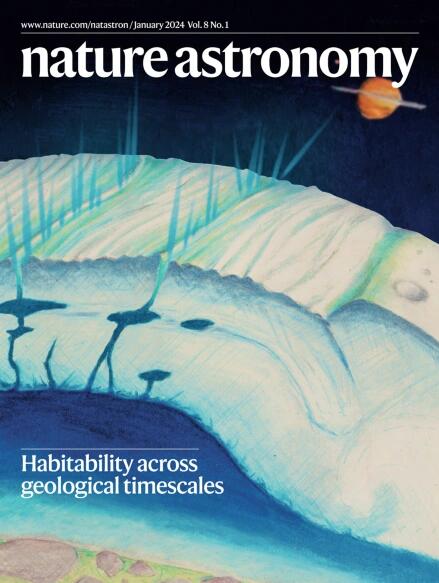木星上的紫外线暗极地椭圆形是磁层与大气层联系的示踪剂
IF 12.9
1区 物理与天体物理
Q1 ASTRONOMY & ASTROPHYSICS
引用次数: 0
摘要
木星平流层中的气溶胶形成了引人入胜的极罩,卡西尼号和哈勃太空望远镜上的紫外线照相机对这些极罩进行了研究。在南北两极罩内都发现了来源不明的瞬时浓缩暗椭圆。然而,由于观测不频繁,尚未对它们的特性进行系统的比较研究,而这种研究可以阐明活跃在两极的物理过程。利用哈勃在 1994 年至 2022 年间拍摄的 26 幅木星全球地图,我们探测到瞬时紫外线暗椭圆在南部出现的频率为 48% 至 53%。我们发现南部暗椭圆的出现频率是北部暗椭圆的 4 到 6 倍。南部的特征是一个反气旋涡旋,在其生命周期的大部分时间里都保持在极光椭圆内。椭圆形的黑暗与灰霾丰度增加 20 至 50 倍或平流层灰霾分布整体上移相一致。相对于其周围环境,暗椭圆的反气旋涡度增强了,这代表了之前报告的热层和上平流层高空涡度的深度延伸。霾的增强可能是由磁层动量交换驱动的,增强的气溶胶产生了以前红外探测到的局部加热。本文章由计算机程序翻译,如有差异,请以英文原文为准。


UV-dark polar ovals on Jupiter as tracers of magnetosphere–atmosphere connections
Aerosols in Jupiter’s stratosphere form intriguing polar hoods, which have been investigated by ultraviolet cameras on Cassini and the Hubble Space Telescope. Transient, concentrated dark ovals of unknown origin have been noted within both the northern and southern polar hoods. However, a systematic comparative study of their properties, which could elucidate the physical processes active at the poles, has not yet been performed due to infrequent observations. Using 26 global maps of Jupiter taken by Hubble between 1994 and 2022, we detected transient ultraviolet-dark ovals with a 48% to 53% frequency of occurrence in the south. We found the southern dark oval to be 4 to 6 times more common than its northern counterpart. The southern feature is an anticyclonic vortex and remains within the auroral oval during most of its lifetime. The oval’s darkness is consistent with a 20 to 50 times increase in haze abundance or an overall upward shift in the stratospheric haze distribution. The anticyclonic vorticity of the dark oval is enhanced relative to its surroundings, which represents a deep extension of the higher-altitude vortices previously reported in the thermosphere and upper stratosphere. The haze enhancement is probably driven by magnetospheric momentum exchange, with enhanced aerosols producing the localized heating detected in previous infrared retrievals. Thirty years of Hubble data reveal transient UV-dark ovals more frequently in the south. Momentum from the magnetosphere penetrates downwards to concentrate and shift the haze distribution within the ovals.
求助全文
通过发布文献求助,成功后即可免费获取论文全文。
去求助
来源期刊

Nature Astronomy
Physics and Astronomy-Astronomy and Astrophysics
CiteScore
19.50
自引率
2.80%
发文量
252
期刊介绍:
Nature Astronomy, the oldest science, has played a significant role in the history of Nature. Throughout the years, pioneering discoveries such as the first quasar, exoplanet, and understanding of spiral nebulae have been reported in the journal. With the introduction of Nature Astronomy, the field now receives expanded coverage, welcoming research in astronomy, astrophysics, and planetary science. The primary objective is to encourage closer collaboration among researchers in these related areas.
Similar to other journals under the Nature brand, Nature Astronomy boasts a devoted team of professional editors, ensuring fairness and rigorous peer-review processes. The journal maintains high standards in copy-editing and production, ensuring timely publication and editorial independence.
In addition to original research, Nature Astronomy publishes a wide range of content, including Comments, Reviews, News and Views, Features, and Correspondence. This diverse collection covers various disciplines within astronomy and includes contributions from a diverse range of voices.
 求助内容:
求助内容: 应助结果提醒方式:
应助结果提醒方式:


